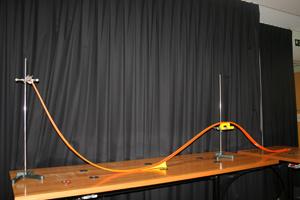Ma-5 Hotwheels Track
Aim
To demonstrate that an object rolled down a U-shaped track will roll up to the same height as it was released. Also, if the object (Hot-wheels car) is rolled down a hill onto a flat track, the object will keep rolling until it is acted upon by an outside force.
Apparatus
- Hot-wheels track set
- Hot-wheels car

Hot Wheels Track.
Description
In the 17th C, Galileo realised there serious anomalies in the way most of humanity understood the way mechanical objects move. By some careful experiments he was able to correct these anomalies. One problem he corrected was the idea that a constant force was necessary to keep an object in motion. He reasoned that an object rolling down from the top of a hill will have enough energy when it gets to the bottom of the hill to then roll up the next hill to the same height. Of course some corrections must be made for friction. This can easily be demonstrated by making a U-shaped dip in the hot-wheels track and rolling a car or a marble from the top of one side of the U.
But then what happens if the hills are a little way apart? Inserting a extra flat bit of track at the bottom of the U makes no difference. The car or marble will again roll back up to close to the same height.
So Galileo now reasoned that if the second hill is removed, the car or marble will roll off for ever searching for the second hill to ascend. With the hot-wheels track and the front bench of the lecture theatre, it is possible to demonstrate that the car or marble will travel right across the theatre looking for the next hill.
NB: It is important to point out that Galileo's apparatus did not look exactly like the hot-wheels track and associated cars.